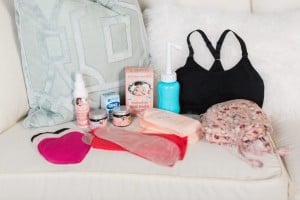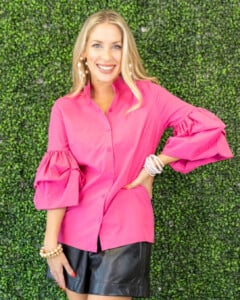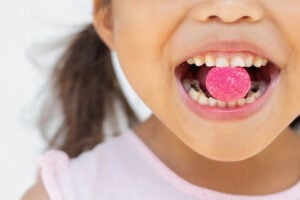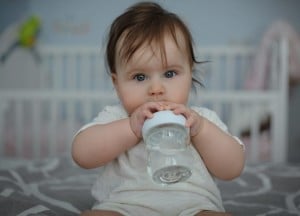There’s nothing more precious to us than our babies and children. Although we can’t control everything in their lives, we can control certain things, like the products we use on them or expose them to. This is why it’s important to apply only the healthiest of products on the outsides of their bodies. We might not realize this, but everyday baby products — shampoos, lotions, bath gels, sunscreens, etc. — contain ingredients that can be extremely harmful.11 These ingredients can potentially cause short- or long-term health issues. Some of these issues can be apparent immediately on baby’s skin after use. Other times, the issues can be invisible, disrupting their bodies in ways we can’t immediately see with the naked eye.11 Let’s explore why this happens and discuss what toxins to avoid in your baby’s skin care products.
Why Are Certain Skin Care Ingredients Harmful for Babies?
In a pound-for-pound ratio, a baby consumes more food, air, and water than an adult. Babies also absorb things at a much higher rate than adults.1,15 This is because the top layer of a baby’s skin is 30% thinner than an adult’s.1 This leads them to absorb ingredients much more effectively than we do.
There’s a process known as bioaccumulation. This means that over time, the excessive toxin exposure will build up, accumulate, and make it harder for the body to break down.12,13 When we use any product on our baby’s skin, the ingredients (some highly toxic) are absorbed into their bodies.14 And since toxic ingredients are harder to break down, they can weaken a baby’s immune system, behavior, skin health, and much more.
Tools for Identifying Toxins in Baby Products
The Environmental Working Group has a database available to the public where you can plug in every ingredient listed on a baby product. This database lists the toxicity of each ingredient on a 1-to-10 scale — with 1 being the safest and 10 being the most toxic. If you do that for conventional baby products, you’ll see that most of their ingredients go as high as a 10 in their toxicity ratings.
The “Think Dirty” app is also a massive eye-opener for some moms. This app allows you to scan your favorite baby products and see how toxic they are to use on your little ones.
5 Toxins To Avoid in Baby Products
Here are five specific toxins to look out for and avoid when choosing skin care products for your baby:
1. Sulfates
Popular ingredients in store-bought baby soaps and cleansers are sulfates (SLS).2 Shampoos and baby washes include these to cause the product to “foam” or “bubble up.”18 Some think that the more bubbles a shampoo creates, the more effective it is. However, sulfates are highly toxic to the body. According to the Environmental Working Group database and other research, SLS has been linked to cancer, neurotoxicity, organ toxicity, skin irritation, and endocrine disruption.16,17
2. Dyes
While bright blue, emoji yellow, or neon pink might look fun, the chemicals that help turn products into all the colors of the rainbow aren’t fun at all. Studies show that dyes in foods and products used on the skin are damaging, yet they’re still used and sold daily. Many dyes have the potential to cause horrible health issues. These include chromosomal damage, tumors, hyperactivity, lymphomas, neurochemical effects, asthma, insomnia, allergies, and eczema.3,19,20,21,22,23
3. Parabens
Parabens are synthetic preservatives. They’re associated with ingredient names like methylparaben, ethylparaben, butylparaben, and propylparaben.4 Companies put these in skin care products to cause them to last longer and not go bad over a short period of time.24 Studies have shown that parabens can mimic or imitate hormonal activity in the body.7 It’s also been associated with forms of breast cancer, and traces of parabens have even been found in breast tumors.9
4. Phthalates
Phthalates are industrial chemicals that soften plastics and act as solvents in many topical creams, soaps, and other skincare products.5,26 Many children’s toys have banned their use.8 However, a lot of baby care products still use them.25 Studies have shown that phthalates are highly damaging to the liver, kidneys, lungs, and reproductive systems.5,10
5. Fragrances
Many baby products contain the listed ingredient “fragrance,” which is simply a broad category that hides hundreds of toxic chemicals behind that word. Companies aren’t required to reveal the chemicals within the “fragrance” category.6 Unfortunately, this keeps the public in the dark about the toxicity of our products on our little ones. These chemicals are linked to birth defects, cancer, nervous system disorders, allergies, etc.6,27
Remember: Always Read the Ingredients
Being a mom is hard. Many of us—including me — are guilty of using products on our little ones with hidden ingredients. So there’s no judgment here! However, it’s important for us to educate ourselves and learn to ditch the toxins for our children’s health.
So what can you do? Be a conscious ingredient reader! Check the back of each baby product and see for yourself what it contains. There are many wonderful skin care products that are free from synthetic chemicals and can be a much better choice for your little one’s health. Your baby is worth it, mama. And so are you! You’re totally rocking this mom thing. Remember, there’s no one more fitting to be your child’s mother than YOU!





























